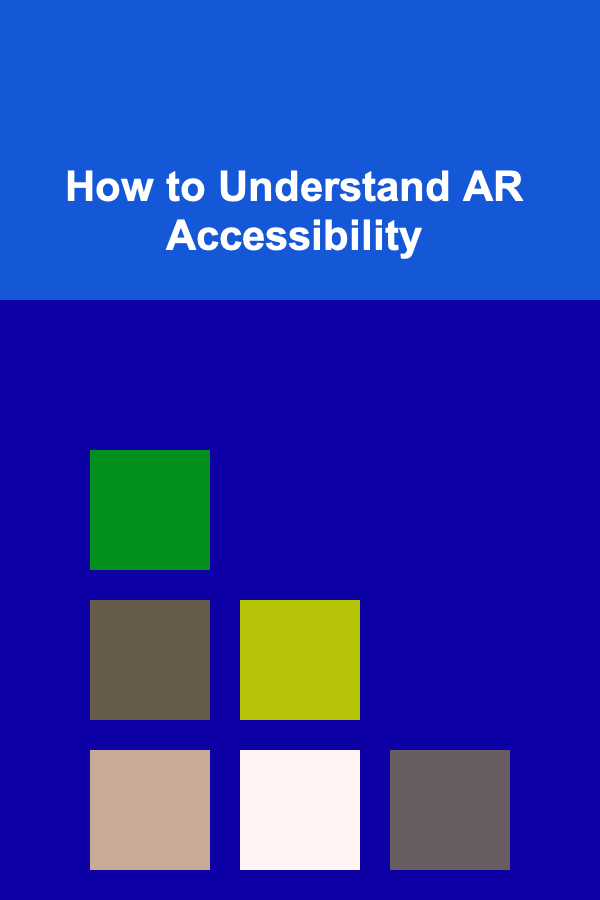
How to Understand AR Accessibility
ebook include PDF & Audio bundle (Micro Guide)
$12.99$7.99
Limited Time Offer! Order within the next:

Augmented Reality (AR) is a technology that enhances the real-world environment by overlaying digital content, such as images, sounds, and information, onto the physical world. AR has the potential to revolutionize various sectors, including healthcare, education, entertainment, and retail. However, as AR technology becomes more prevalent, it's essential to address accessibility concerns, ensuring that it serves diverse populations, including people with disabilities. This article will explore the concept of AR accessibility, its importance, challenges, and potential solutions for improving access to AR experiences for everyone.
What is AR Accessibility?
AR accessibility refers to the design and implementation of AR systems, applications, and experiences in a way that ensures people with disabilities or impairments can use and benefit from them. This includes considering a wide range of disabilities, such as visual, auditory, cognitive, and motor impairments, to ensure that AR applications are usable and beneficial for all users.
The ultimate goal of AR accessibility is to provide an inclusive experience where digital enhancements do not hinder a user's ability to interact with the real world but rather support and enhance it. To achieve this, AR systems need to be designed with a deep understanding of how people with different disabilities interact with technology and their specific needs.
The Importance of AR Accessibility
With the rapid growth of AR technology in various industries, the issue of accessibility becomes critical. As AR applications are integrated into everyday life, there is a significant opportunity to enhance the lives of people with disabilities. For example, AR can be used to help people with visual impairments navigate unfamiliar environments by providing real-time audio feedback or guiding them with visual cues.
However, without proper accessibility features, these advancements could inadvertently exclude people who would benefit the most from AR. Ensuring AR accessibility is crucial not only to comply with legal regulations and standards, but also to create more inclusive and equitable opportunities for all users.
The Benefits of AR for People with Disabilities
- Improved Mobility and Navigation: For people with visual impairments or cognitive disabilities, AR can provide real-time navigation and assistance. By overlaying directions, landmarks, and other key information onto the physical environment, AR can guide users through unfamiliar spaces, reducing the reliance on others and promoting independence.
- Enhanced Communication: For individuals with hearing impairments, AR can enable real-time transcription or subtitles during interactions, ensuring that people with hearing disabilities can engage in conversations, lectures, or presentations without barriers.
- Personalized Learning: In education, AR can be used to create interactive learning experiences tailored to the needs of students with disabilities. For example, AR can provide auditory or tactile feedback for students with learning disabilities or those with visual impairments.
- Empowerment and Inclusion: AR can help people with disabilities feel more included in social, educational, and professional settings. It can empower them by providing tools that enhance their interaction with the world around them.
The Challenges of AR Accessibility
Despite the potential of AR to enhance the lives of people with disabilities, there are several challenges to achieving comprehensive AR accessibility. These challenges primarily revolve around technological limitations, design considerations, and a lack of awareness of the needs of people with disabilities.
1. Technological Barriers
One of the main challenges in creating accessible AR experiences is the technology itself. Many AR applications are built with the assumption that users have full sensory and motor capabilities, which leaves out individuals with various disabilities. For instance, if an AR system relies heavily on visual cues, it would be inaccessible to people with visual impairments unless additional accessibility features, such as audio descriptions, are included.
Similarly, the hardware used to access AR experiences (e.g., smartphones, AR glasses, or headsets) may not be designed with accessibility in mind. These devices often require precise motor control, which can be difficult for users with motor impairments. Additionally, the user interfaces may not be optimized for individuals with cognitive disabilities, making it difficult for them to navigate and interact with AR content.
2. Designing for Diverse Needs
AR applications need to be designed with accessibility in mind from the outset. However, this requires a deep understanding of the diverse needs of users with disabilities, which may not always be a priority for developers. It is essential that AR creators prioritize inclusivity during the design phase to ensure that their applications are usable by everyone.
For example, people with visual impairments often rely on screen readers or other assistive technologies. However, if an AR application does not integrate with these tools, it will be inaccessible to a large group of users. Similarly, for individuals with motor impairments, AR interactions that require precise gestures or physical actions may be difficult or impossible to perform.
3. Lack of Standards and Regulations
Currently, there are no universally accepted standards or regulations for AR accessibility. While there are guidelines for general accessibility in digital design (such as the Web Content Accessibility Guidelines, or WCAG), these do not always account for the unique features and challenges of AR technology.
This lack of standardization can lead to inconsistencies in the accessibility of AR applications. Developers may not be aware of the specific needs of users with disabilities or may not know how to implement accessibility features properly. Without clear guidelines, there is a risk that AR technology will remain inaccessible to large segments of the population.
4. Cost and Resources
Developing accessible AR applications can be costly and time-consuming. It requires not only specialized knowledge of accessibility features but also the development of new hardware or software solutions. Many AR developers may not have the resources or expertise to incorporate accessibility features into their applications.
Additionally, accessibility often requires ongoing testing and iteration to ensure that the features work effectively for all users. This can be a significant barrier for small developers or organizations with limited budgets.
Solutions to Improve AR Accessibility
Despite these challenges, there are several approaches that can be used to make AR more accessible. By implementing inclusive design principles, improving technology, and fostering collaboration between developers, accessibility experts, and users with disabilities, we can make AR experiences more inclusive and accessible.
1. Inclusive Design Principles
Inclusive design is a design approach that seeks to create products and services that are usable by as many people as possible, regardless of their abilities. When applied to AR, inclusive design principles focus on ensuring that all users can access and interact with the technology, regardless of their disabilities.
For example, AR applications can be designed with customizable settings that allow users to adjust the experience according to their specific needs. This could include options to increase text size, change contrast, provide audio descriptions, or modify the complexity of interactions. By allowing users to tailor the AR experience, developers can accommodate a wider range of disabilities.
2. Collaboration with Accessibility Experts
One of the most effective ways to improve AR accessibility is to collaborate with experts in the field of accessibility and disability inclusion. By working closely with people who have disabilities, developers can gain valuable insights into how AR can be better designed to meet their needs.
Incorporating feedback from users with disabilities throughout the design and development process is essential for creating accessible AR experiences. This can include usability testing with individuals who have visual, auditory, motor, or cognitive impairments to ensure that the application meets their needs.
3. Integration with Assistive Technologies
AR systems should be designed to integrate seamlessly with assistive technologies such as screen readers, speech recognition software, and alternative input devices. By ensuring that AR applications are compatible with these tools, developers can help users with disabilities access and interact with AR content more easily.
For instance, AR applications can provide audio descriptions for users with visual impairments, describing the key elements of the AR experience in real-time. Similarly, for users with motor impairments, developers can offer alternative input methods, such as voice commands or eye-tracking technology, to interact with the AR system.
4. Clear Standards and Guidelines
The establishment of clear, universally accepted standards and guidelines for AR accessibility is essential for ensuring that developers create inclusive applications. These standards can be based on existing accessibility guidelines, such as the WCAG, but should be tailored to address the unique challenges of AR technology.
Governments, industry organizations, and advocacy groups should work together to create and promote these standards. By providing developers with clear guidelines on how to make their AR applications accessible, we can ensure that AR technology is inclusive and beneficial to all users.
5. Educating Developers
Developers need to be educated on the importance of accessibility and how to incorporate accessibility features into their AR applications. This can be achieved through training programs, workshops, and resources that provide developers with the knowledge and tools they need to create accessible AR experiences.
By raising awareness of accessibility issues in the AR community, we can foster a culture of inclusivity and encourage developers to prioritize accessibility from the outset.
Conclusion
AR accessibility is a crucial aspect of the development and implementation of AR technology. As AR becomes more integrated into various industries and everyday life, it is essential that developers consider the needs of people with disabilities to ensure that these technologies are inclusive and accessible. By adopting inclusive design principles, collaborating with accessibility experts, integrating assistive technologies, and establishing clear guidelines, we can create AR experiences that empower people with disabilities and promote independence, inclusion, and equal access to digital advancements.
Through continuous innovation and collaboration, we can ensure that AR serves everyone, not just a select few, and contributes to a more accessible and equitable digital future.

Affordable Hobbies and Activities: Enjoying Your Free Time Without Breaking the Bank
Read More
How to Create a Family Fitness Zone for All Ages
Read More
How to Organize Your Sewing or Crafting Area
Read More
How to Sell Vintage Watches on Instagram: An Actionable Guide
Read More
How to Use Podcasting Equipment to Make Money
Read More
Mastering Biomedical Engineering: A Comprehensive Handbook for Aspiring Engineers
Read MoreOther Products

Affordable Hobbies and Activities: Enjoying Your Free Time Without Breaking the Bank
Read More
How to Create a Family Fitness Zone for All Ages
Read More
How to Organize Your Sewing or Crafting Area
Read More
How to Sell Vintage Watches on Instagram: An Actionable Guide
Read More
How to Use Podcasting Equipment to Make Money
Read More